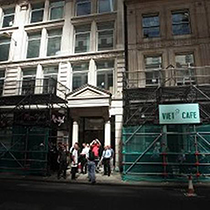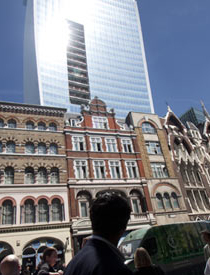"Walkie Talkie" Building "Melts" Cars
- 作者
- John Hill
- 发布于
- 9月 9, 2013


On August 28, City A.M.—a London-based free business daily—reported that the "Walkie Talkie" office tower nearing completion at 20 Fenchurch Street, designed by Rafael Viñoly Architects, was "scorching Londoners." But it wasn't until the paper's story the following week of a Jaguar damaged by the sun's reflections off of the skyscraper that people took notice. The story spread like wildfire, prompting the new monikers "Walkie Scochie" and "Fryscraper," and for City A.M. to even demonstrate—having a considerable amount of fun with the story—how the rays fried an egg. Following the news, developers Land Securities and Canary Wharf Group erected screens to shield the affected areas, a temporary measure until a final solution is found.
The problem arises from two design features: the concave shape of the south-facing façade, which concentrates the reflected rays on a single spot (which happened to be a Jaguar one day); and the fins that Viñoly designed for the elevation to reduce glare were removed by the developers as a cost-cutting measure. The architect told the Guardian that he knew it would be a problem, but not to the extent it is: "When it was spotted on a second design iteration, we judged the temperature was going to be about 36 degrees. But it's turned out to be more like 72 degrees. They are calling it the 'death ray', because if you go there you might die. It is phenomenal, this thing."
Viñoly designed a similar concave elevation for the Vdara Hotel & Spa at CityCenter in Las Vegas (per a masterplan that specified such a shape), which sent a concentrated beam of light down to the pool in 2010. A non-reflective film was added to that façade to mitigate the problem, pointing to what might be happening at 20 Fenchurch Street in the near future.
The problem arises from two design features: the concave shape of the south-facing façade, which concentrates the reflected rays on a single spot (which happened to be a Jaguar one day); and the fins that Viñoly designed for the elevation to reduce glare were removed by the developers as a cost-cutting measure. The architect told the Guardian that he knew it would be a problem, but not to the extent it is: "When it was spotted on a second design iteration, we judged the temperature was going to be about 36 degrees. But it's turned out to be more like 72 degrees. They are calling it the 'death ray', because if you go there you might die. It is phenomenal, this thing."
Viñoly designed a similar concave elevation for the Vdara Hotel & Spa at CityCenter in Las Vegas (per a masterplan that specified such a shape), which sent a concentrated beam of light down to the pool in 2010. A non-reflective film was added to that façade to mitigate the problem, pointing to what might be happening at 20 Fenchurch Street in the near future.